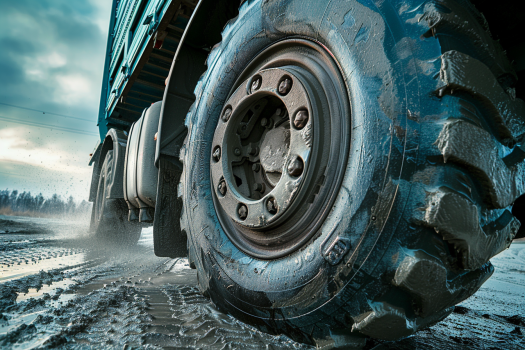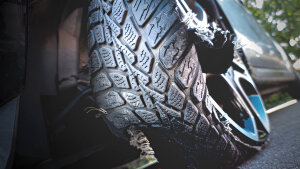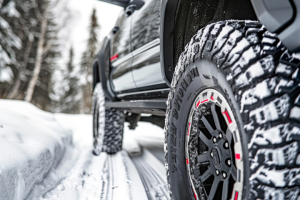Last Updated on September 21, 2025
Learn the Best Way to Rotate Truck Tires to Maximize Longevity and Safety
Regular tire rotation is essential for trucks! It helps your tires last longer and perform better.
Trucks, whether used for work or fun, put a lot more stress on tires than cars. This is due to heavier loads, longer travel distances, and often more challenging driving conditions. So, truck tire rotation isn’t just a recommended maintenance task; it’s a critical necessity.
In this guide, you’ll understand tire rotation as an essential part of truck maintenance, its benefits, and how you can do it as a truck owner. Ready for this and more? Then keep reading!

What Is Tire Rotation?
Tire rotation refers to moving tires from one position on a vehicle to another to ensure even tire wear. For trucks, which often face heavy loads and long driving distances, tire rotation is crucial in managing tire wear and extending tire life. The main goal of this procedure is to achieve uniform wear for all tires, which helps maintain the vehicle’s handling and safety.
Each tire and wheel is removed from the vehicle during tire rotation and moved to a different position. This can involve moving the front tires to the rear and the rear tires to the front, often switching sides.
The specific pattern of rotation can vary depending on several factors, including the type of tires (directional or non-directional), the vehicle’s drive train (front-wheel, rear-wheel, all-wheel, or four-wheel drive), and whether the truck uses dual rear wheels.
Overview of Benefits
The benefits of regular tire rotation are comprehensive, affecting everything from safety to cost-efficiency. Here are some of the key advantages:
Extended Tire Life:
One of the primary reasons tire rotation is essential for trucks is to reduce the effect of uneven wear patterns that can develop over time. Trucks often have different weight distributions depending on their cargo, leading to uneven tire wear. For instance, the front tires on a heavily loaded truck can wear out faster than the rear ones because they bear the brunt of the steering and braking forces. Without regular rotation, these tires could suffer premature wear, leading to the need for earlier replacement and potentially higher operational costs.
Improved Performance:
Evenly worn tires provide better handling, braking, and traction. For trucks, this means improved safety and responsiveness in various driving conditions, essential for vehicles that often operate in fluctuating weather conditions and terrains.
Enhanced Safety:
Uniform tire wear is critical for maintaining trucks’ handling characteristics. Unevenly worn tires can lead to handling issues, such as pulling to one side. Regular tire rotation helps maintain good handling, thus enhancing the vehicle’s safety by reducing the risk of accidents due to tire failure.
Moreover, tire rotation helps maintain an even balance in tire tread depth, which is crucial for safe driving conditions. Even tread depth across all tires ensures better traction, stability, and handling. This is particularly important for trucks due to heavy loads, which can significantly influence the vehicle’s braking and cornering abilities.
Cost Efficiency:
By extending the overall life of the tires through rotation, truck owners can reduce the cost per mile of tire wear. Furthermore, consistent wear helps maintain the truck’s fuel efficiency, and tires require less energy to turn, especially under heavy loads.
Preventive Maintenance:
Regular tire rotation allows for frequent inspection of tires for damages, air pressure issues, and other potential tire problems. Early detection of such issues can prevent more severe problems, avoiding costly repairs and downtime.
Enhanced Braking Performance:
Evenly worn tires have a more predictable response to braking, which is vital for safety, especially for heavy vehicles like trucks. Discrepancies in tread depth can lead to uneven braking pressure, which might increase stopping distances or contribute to vehicle skidding.
Reduced Risk of Blowouts and Failures:
Tires with uneven wear are more susceptible to damage and blowouts, as weaker parts are more exposed to failure under stress. Regular rotation helps reduce this risk by promoting more uniform wear and allowing tires to be inspected frequently for potential issues.
Warranty Requirements:
Many tire manufacturers require regular tire rotation as a condition of their warranty coverage. Failure to adhere to prescribed rotation schedules can void warranty claims, leaving truck owners to bear the total cost of premature tire failures.
How Often Should Truck Tires Be Rotated?
The tire rotation frequency can vary based on the truck’s usage, tire type, and manufacturer recommendations. However, a general rule of thumb is to rotate truck tires every 6,000 to 8,000 miles. This interval ensures that the tires are inspected and rotated before significant uneven wear develops, particularly crucial for trucks due to their operational demands.
Nonetheless, here are a few factors that can help you determine when and how often to rotate tires.
Manufacturer’s Recommendations:
Check the vehicle owner’s manual or consult the tire manufacturer for specific recommendations. Some manufacturers might specify different intervals based on the tire’s design or the vehicle’s configuration.
Type of Operation:
Trucks used in severe service conditions, such as frequent starting and stopping or on rough terrain, might require more frequent tire rotations. In contrast, long-haul trucks that primarily travel on highways may adhere to the standard rotation intervals.
Tire Wear Observations:
Regularly checking the tread depth and overall condition of the tires can help determine the need for rotation. If there is noticeable uneven wear, or if the truck begins to handle differently, a tire rotation may be necessary sooner than scheduled.
Tire Type:
The type of tire can also influence the rotation frequency. For example, tires designed for off-road use or winter tires might have different wear characteristics than standard all-season tires. Additionally, trucks with directional tires, designed to rotate in a specific direction, might have different rotation patterns than non-directional tires.
Service Schedules:
Integrating tire rotation into regular maintenance schedules, such as during oil changes or another routine service, can ensure that tires are rotated adequately. This practice simplifies maintenance planning and helps prevent oversight of tire rotation needs.
Tire Rotation Patterns for Trucks: Ensuring Optimal Tire Wear and Vehicle Performance
It’s not just about getting a tire rotation for your truck. It would help if you also considered the different rotation patterns. The thing is that different rotation patterns are used because each tire on a vehicle experiences different types and amounts of wear depending on its position and the vehicle’s drivetrain configuration.
For instance, front tires tend to wear differently from rear tires due to factors like steering, braking, and weight distribution. So, by following specific rotation patterns, such as front-to-back, side-to-side, or crisscross, you can help distribute wear more evenly across all four tires.
Then, what are these patterns?
Standard Rotation Patterns Explained
Tire rotation patterns depend mainly on the type of drive train, the uniformity of tire sizes, and whether the tires are directional or non-directional. Here are some of the most common rotation patterns used for trucks:
Rearward Cross:
This pattern is typically used for rear-wheel-drive (RWD) trucks. The rear tires are moved to the front on the same side of the vehicle, while the front tires are moved to the opposite sides of the rear axle. This pattern helps out the wear since the rear tires in RWD vehicles tend to wear faster due to the driving force.
Forward Cross:
Commonly used for front-wheel-drive (FWD) trucks, this pattern involves moving the front tires straight back to the rear, and the rear tires are moved diagonally to the opposite front positions. This addresses the faster wear typically seen on the front tires of FWD vehicles.
X-Pattern:
Suitable for four-wheel-drive (4WD) or all-wheel-drive (AWD) trucks, the X-pattern involves swapping the tires diagonally – front right to rear left and front left to rear right. This pattern is effective for vehicles with tires of the same size and type, ensuring even wear across all four tires.
Modified X-Pattern:
This pattern is similar to the X-pattern, but can be used only when the front and rear tires are rotated without considering side swapping. It’s a variation often used when specific vehicle constraints or modifications prevent standard cross patterns.
Adapting Patterns for Different Truck Configurations
Truck configurations can vary significantly, which means tire rotation strategies may need to be adapted to accommodate different setups:
Dual Rear Wheels (DRW):
Owning a truck with double tires in the back (like many heavy-duty pickups and work trucks) means following a particular tire rotation routine. This usually involves switching the inner and outer tires on each side. Depending on your truck’s setup, the tires might also be moved from the front to the back. The main reason is to ensure all your tires wear evenly, especially since they carry a heavier load.
Directional Tires:
Trucks equipped with directional tires that rotate in one direction due to their tread pattern require a straight front-to-back rotation. This means the front left tire moves to the rear left, and the front right tire moves to the rear right without crossing over to maintain the directional integrity of the tire tread.
Different-Sized Tires:
Some trucks may have different tire sizes on the front and rear axles, complicating the rotation pattern. In such cases, tires can only be rotated side-to-side on the same axle unless specifically designed otherwise.
Full-Size Spare Tire Inclusion:
If a truck has a full-size spare tire that matches the other tires, it should be included in the rotation cycle. This helps maintain even wear on all tires, including the spare, ensuring it is not overly aged or worn when needed.

Special Considerations for Different Types of Trucks
Trucks come in various configurations, each with unique demands and challenges regarding tire maintenance and rotation. Understanding the specific needs of single-rear-wheel (SRW) trucks, dual rear-wheel (DRW) trucks, and all-wheel drive (AWD) trucks is essential for optimal tire care and vehicle performance. So, what are the best practices for maintaining tires across different truck types? Let’s look into each type!
Single Rear Wheel Trucks:
Single rear-wheel trucks are the most common type of pickup truck. These vehicles typically use the same size tires on all four wheels, which allows for more flexibility in rotation patterns.
The most common patterns for SRW trucks include the rearward cross, forward cross, and X-pattern. These patterns help distribute wear evenly across all tires, which is crucial given the varied roles of the front and rear tires in vehicle dynamics.
Also, SRW trucks, if used in personal or light commercial settings, might not face the severe wear conditions seen in heavier-duty trucks. However, regular rotation is critical to avoid uneven wear due to alignment issues or unbalanced loads.
Dual Rear Wheel Trucks:
Trucks with double tires in the back, which are standard for heavy-duty jobs, have special needs. Often seen in commercial applications, these workhorses have two wheels on each side of the rear axle for extra support. Due to this unique setup, they require specific care considerations.
For instance, rotation options may be limited. The standard practice often involves swapping the front and rear tires and rotating the outer and inner rear tires.
Also, DRW trucks carry heavier loads, leading to faster and more uneven tire wear if not regularly maintained. The inner and outer rear tires can wear differently based on load distribution and road conditions, necessitating more frequent inspections and potential adjustments in rotation strategy.
Considerations for All-Wheel Drive (AWD) Trucks
All-wheel drive trucks distribute power to all four wheels, which can lead to unique wear patterns and challenges. Firstly, AWD systems rely on the uniform performance of all four tires to effectively manage power distribution and traction. So, uneven tire wear can lead to drivetrain stress and reduced performance, making regular rotation crucial.
Also, due to the continuous engagement of all four wheels, AWD trucks may benefit from more frequent tire rotations than their two-wheel-drive counterparts. Adhering to a rotation schedule closer to every 5,000 miles might be advisable.
The X-pattern is generally recommended for AWD trucks unless the manufacturer specifies otherwise. This is because the pattern ensures that each tire serves in front and rear positions, helping to even out the wear more effectively.
In addition to regular rotation, AWD truck owners should be vigilant about tire pressure checks and alignments. Discrepancies in tire pressure or misalignments can exacerbate wear issues and impact the AWD system’s efficiency.
Step-by-Step Best Way to Rotate Truck Tires: Tools and Procedures for Effective Maintenance
Proper tire rotation is a crucial maintenance task that extends the life of truck tires and enhances vehicle safety and performance. Here, we’ll provide a detailed, step-by-step approach to rotating tires on various truck models, including the tools needed and specific steps for single—and dual-rear-wheel trucks.
Tools and Preparations Needed
Before you begin the tire rotation process, ensuring you have the right tools and preparing the workspace is essential. Here’s what you’ll need:
- Lug Wrench: Remove and tighten the lug nuts.
- Jack: To lift the truck. Make sure you have a jack that can safely support the weight of your vehicle.
- Jack Stands: To securely hold the car lifted during the rotation process.
- Torque Wrench: To ensure the lug nuts are tightened to the manufacturer’s specifications.
- Chocks: To block the tires still on the ground to prevent the truck from rolling.
- Gloves and Safety Glasses: For personal protection.
- Owner’s Manual: This is for specific instructions related to tire rotation patterns and torque specifications.
Preparation Steps:
- Ensure the truck is parked on a level surface and the parking brake is engaged.
- Place wheel chocks around the tires that won’t be lifted.
- Gather all necessary tools and place them within easy reach.
Detailed Steps for Various Truck Models
The steps to rotate your truck tires can vary slightly depending on whether your truck has single rear wheels (SRW) or dual rear wheels (DRW) and the drivetrain (FWD, RWD, AWD).
For Single Rear Wheel (SRW) Trucks:
- Loosen the Lug Nuts: Using the lug wrench, slightly loosen the lug nuts on all wheels without entirely removing them.
- Lift One Side of the Truck: Use the jack to lift one side of the truck and secure it with jack stands.
- Remove the Wheels: Fully remove the lug nuts and take off the wheels. Follow the appropriate rotation pattern for your truck’s drivetrain.
- Install the Wheels in New Locations: Place each wheel in its new location. Hand-tighten the lug nuts.
- Lower the Truck and Tighten Lug Nuts: Lower the truck back to the ground and tighten the lug nuts with the torque wrench to the manufacturer’s specifications.
- Repeat for the Other Side: Repeat the process for the other side of the truck.
For Dual Rear Wheel (DRW) Trucks:
- Loosen Lug Nuts and Lift the Truck: Similar to SRW, you may need to lift the entire rear or front end, depending on the rotation pattern.
- Rotate Front to Rear: Typically, the front tires move to the rear, and the rear tires move to the front. Depending on their wear, you may also need to swap the inner and outer rear tires.
- Reinstallation and Tightening: Reinstall the tires in their new positions, lower the truck, and tighten the lug nuts to specification.
All-Wheel Drive (AWD) Trucks:
- Follow an X-Pattern Rotation: Use the X-pattern unless otherwise specified for AWD trucks. This involves moving the front right tire to the rear left position and vice versa, the same with the other two tires.
- Attention to Torque: AWD trucks often require specific torque requirements due to their drivetrain complexity. Always refer to the owner’s manual for exact figures.
Professional Tips and Tricks: Expert Advice for Optimal Tire Maintenance and Common Mistakes to Avoid
Maintaining truck tires in top condition is crucial for extending tire life and ensuring the safety and efficiency of truck operations. Here are expert tips and tricks for optimal tire maintenance, along with common pitfalls that truck owners and operators should avoid.
Expert Advice for Optimal Tire Maintenance
1. Regular Tire Inspections:
- Check Tread Depth Regularly: Ensure tire tread depth is within safe operating limits. Use a tread depth gauge to measure. The minimum legal tread depth is 1.6 mm, but replacing tires before they reach this limit is advisable.
- Look for Signs of Wear and Damage: Regularly inspect tires for cuts, punctures, uneven wear, and any signs of sidewall damage. Early detection of these issues can prevent more severe problems down the road.
2. Maintain Proper Tire Pressure:
- Check Pressure Frequently: Tire pressure should be checked at least once a month and before long trips. Use a reliable tire pressure gauge and adjust the pressure according to the manufacturer’s recommendations, which can usually be found on the tire placard on the door frame or in the owner’s manual.
- Adjust for Load and Conditions: Consider the load weight and ambient temperature changes, which can affect tire pressure. Adjustments may be necessary to accommodate heavy loads or significant temperature fluctuations.
3. Rotate Tires Regularly:
- Follow a Set Schedule: Adhere to a regular tire rotation schedule based on your truck’s mileage or the manufacturer’s guidelines. This practice helps ensure even tire wear and extends the life of the tires.
- Use Correct Rotation Patterns: Choose the appropriate rotation pattern for your truck type and tire configuration (directional or non-directional).
4. Use the Right Tires for Your Truck and Driving Conditions:
- Select Appropriate Tire Types: Different types of driving conditions—off-road, highway, mixed-use—require different types of tires. Using the right tires can significantly improve performance and safety.
- Seasonal Tire Considerations: In regions with severe winter conditions, consider using winter tires that provide better traction in snow and ice.
5. Regular Alignment Checks:
Misalignment can cause uneven tire wear and poor handling. Trucks should have their alignment checked periodically, especially if driving performance changes noticeably or after encountering a significant road hazard.
Common Mistakes to Avoid
- Neglecting Tire Pressure Checks: Underinflated or overinflated tires can lead to numerous problems, including increased tire wear, reduced fuel efficiency, and potential tire failures.
- Ignoring Tire Rotation: Failing to rotate tires as recommended can lead to premature tire wear and might void warranty coverage.
- Overloading the Truck: Exceeding the tire’s load capacity can cause excessive heat buildup and might lead to tire failure. Always adhere to the load specifications mentioned on the tire’s sidewall.
- Using Worn-Out Tires: Tires beyond their service life can drastically increase the risk of tire blowouts and accidents.
- Overlooking Regular Inspections: Small issues, such as minor cuts or embedded objects, can develop into severe problems if not addressed promptly.

Conclusion
Rotating your truck tires is super important. It helps them last longer, makes your vehicle work better, and keeps you safe on the road. It would help if you aimed to rotate them regularly, usually every 6,000-8,000 miles. This helps prevent problems like uneven wear and tires wearing out too soon. Chatting with tire pros and doing regular checks when you rotate them is a good idea. This means looking for any damage and making sure the pressure is correct. Doing these things keeps your tires in good shape and ensures they last.
Recommended Services on Tires Easy Truck
Welcome to Tires Easy Truck, your go-to destination for top-notch tires and services tailored for trucks of all kinds. We boast a diverse range of truck tires from leading brands, ensuring you discover the perfect fit for your vehicle and driving preferences. Whether you need routine upkeep, tire rotations, or a fresh set of wheels, our team of experts is here to assist you every step.
We also encourage truck owners and operators to maintain their tires through regular rotations and consider upgrading them to improve performance and safety. Our easy-to-navigate website and knowledgeable staff ensure your tire buying and maintenance experience is straightforward and satisfying.
For those ready to take the next step in ensuring their truck operates at its best, visit Tires Easy Truck today. Check out our extensive tire selection and book your next tire service appointment. Let us help you keep your truck running smoothly and ensure your tires are always in top condition. Click here to find out more and make your purchase.
FAQs
1. Why is tire rotation important for trucks?
Tire rotation helps ensure even tire wear across all tires, extending the life of the tires and maintaining the performance and safety of the truck. Even wear is crucial for maintaining the truck’s handling characteristics, improving fuel efficiency, and preventing premature tire replacement.
2. How often should I rotate my truck tires?
Generally, truck tires should be rotated every 6,000 to 8,000 miles or as specified by the tire manufacturer or truck’s owner manual. However, the ideal frequency can vary based on the truck’s usage, the type of driving (city driving, long-haul, off-road), and the tire type.
3. What are the common tire rotation patterns for trucks?
The tire rotation pattern depends on the type of truck and the tires:
- Rearward Cross: Common for rear-wheel-drive trucks, where rear tires move to the front and front tires move to the opposite rear positions.
- Forward Cross: This is used for front-wheel-drive trucks, where the front tires move directly to the rear and the rear tires move diagonally to the opposite front positions.
- X-Pattern: Suitable for four-wheel-drive or all-wheel-drive trucks, where tires are swapped diagonally.
- Side-to-Side: For trucks with different-sized tires on the front and rear axles, the tires are rotated to different sides on the same axle.
4. Can I rotate my truck tires?
If you have the appropriate tools and knowledge, rotating truck tires can be a DIY task. Essential tools include a jack, jack stands, a lug wrench, and a torque wrench. Following a proper lifting technique is crucial, as securing the truck safely on jack stands before rotating the tires. However, if you’re unsure, it’s always safer to have a tire rotation done by a professional technician.
5. Are there any specific considerations for rotating tires on dual rear-wheel trucks?
Yes, dual rear wheel (DRW) trucks require a specific approach to tire rotation. Typically, the inner and outer tires of the dual sets are rotated with each other, and depending on the truck’s drivetrain, the tires may also need to be rotated from front to back. It’s important to check each tire for signs of uneven wear and address any issues during the rotation.
6. How does tire rotation affect my truck’s warranty?
Many tire manufacturers require regular tire rotation as part of their warranty terms. Failing to adhere to recommended rotation intervals can void warranty coverage for tire wear-related issues. Always check your tire warranty policy for specific requirements regarding tire rotation.
7. What should I check during tire rotation?
During tire rotation, it’s a good opportunity to check for any signs of wear or damage, such as cracks, bulges, or embedded objects. Additionally, check the tire pressure and adjust it according to the manufacturer’s specifications. If necessary, it’s also advisable to check the brakes and wheel alignment.
8. Do all trucks require tire rotation?
While most trucks benefit from regular tire rotation, the specifics can vary based on tire type (directional or non-directional), drivetrain (FWD, RWD, AWD, 4WD), and whether the truck uses standard or specialized tires. Always refer to the manufacturer’s guidelines for your truck and tire setup.










